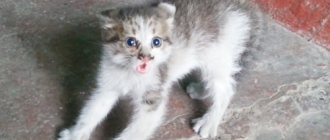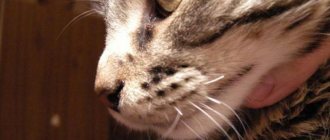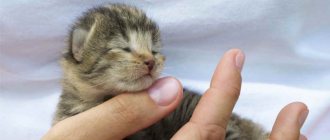Main character traits of a British cat
Before you get a British breed kitten, you need to know that he is not as sociable as other felines. These animals are cold, restrained in emotions and allow themselves to be loved from afar. They accept affection if they are in a good mood.
Main character traits:
- If a child or a new animal appears in the house, the British take it seriously. He is jealous, so he needs attention. Ignoring it from the owner will cause the pet to become upset and begin to mope.
- The arrival of guests may make the cat unhappy, but she will never show it and will behave politely. First, she will sniff the stranger’s things, watch him, and only then will she develop a trusting attitude towards the guest.
- The cat is a housewife by nature and regularly walks around the house. If you close access to the rooms, she will start to get nervous.
- The animal’s behavior is also influenced by the emotional situation in the family. If there is peace and quiet in the house, the cat will behave well, but as soon as scandals and quarrels begin, its character will change dramatically. She will become nervous and will harm family members in every possible way, thus expressing protest.
- This is a touchy and stubborn feline breed. It is impossible to change your pet's mannerisms or force him to perform any actions. He will be offended, hide away from view, and may even bite, causing a wound to the owner.
Be sure to read:
Is it possible to breed a fold-eared cat with a fold-eared cat: why not, with whom to cross
How active and cheerful a cat is depends on its health.
Description of the breed
The British head has a round, regular shape with pronounced rump or cheeks. The nose is short, but smooth and wide. The ears are small, there are two types - slightly rounded, widely spaced and drooping at the tips to the bottom - fold-eared breed. Both types of ears have a wide base. The eyes are quite large, round in shape, widely set, the color is mostly rich golden.
The body of purebred British is muscular, with a wide chest and back, the animal is quite strong and agile. The tail is of medium size in thickness and length; it cannot be called thin and long. In terms of weight category, adult cats are somewhat heavier than cats: males weigh about 5-8 kg , females are smaller - from 4 to 6 kg .
Based on the type of coat, they are distinguished: long-haired and short-haired, but both types have an average length, there is no very noticeable difference - some have wool that is fluffier and longer, smooth, without curls, while others have short, straight, denser hair.
The coat color is even and uniform throughout the body . There are more than thirty varieties of color variations: red, white, gray, cream, black, combining several shades (gray, pink and gray), marble, gray-blue.
The character of the British is characterized by waywardness, partly even touchiness; they are proud and independent.
Behavior of British cats
The behavior of British cats is formed from birth. Little kittens watch their mother and adopt basic habits from her. They quickly get used to the tray and respect the rules of living together with a person.
British habits:
- British cats love cleanliness. If the litter in the tray is old, they will relieve themselves next to it or in any other place. At the same time, the owner’s bed is no exception. Representatives of this breed also do not like sudden changes in the type of filler. To prevent the cat from causing trouble, the owner must regularly monitor the cleanliness of the tray and change the filler on time.
- Demanding about food. If the British do not like the diet, they refuse food and demand a tastier treat from the owner.
- Grooming is the main activity. To get their fur coat in order, cats lick it for hours without switching to another activity. Having been in the owner’s arms, the pet will also begin to lick itself thoroughly, getting rid of the smell of hands, even if it has just “washed itself.” This behavior is inherent in their nature; at the same time, monotonous actions calm and relax them.
- They rarely meow. Most British cats are characterized by quiet behavior; only occasionally there are individuals who are not averse to communicating with their owner. Loud meowing from them can only be heard during the mating season.
- Good hunters. Some owners don't know that their pets are real hunters. In the old days, the British bred British cats to catch rodents. In addition to mice, they are able to catch frogs, lizards, moles and birds. The cat always brings the trophy to the owner to show off the catch. If an animal refuses to hunt, it means that it is not in the hunting mood or is simply tired.
Aggressive cat: what to do and where to run
Cats are very sensitive creatures with a subtle psychology, so their behavior is significantly influenced by external factors, especially strong emotions such as fear.
A cat that is afraid of something takes a characteristic pose - it presses its ears tightly to its head and moves them back, presses its head and body to the ground, tries to become more invisible, in many cases the animal simply tries to run away.
If it doesn’t run away, it tries to defend itself. A cat that is ready to defend itself looks like this - it raises its paws and swings them, makes sounds similar to spitting, hisses, its fur stands on end (especially on the tail, head and back), its back arches and the animal moves sideways forward, so a cat tries to show its superiority (including in size) and intimidate the enemy.
In most cases, fear is the main cause of aggression in cats. If your pet is timid, you should never deliberately provoke fear; you should also ask your friends and acquaintances to approach the animal slowly, not abruptly, and say kind words as they do so. Only in this way can possible aggression on his part be neutralized.
If the cat is ready to attack, is aggressive, you can spray water on it from a spray bottle, this will cool its ardor. If an animal scratches a smooth surface out of despair, it means that it has lost control of the situation. In this case, you need to put some kind of rug on the cat so that she can sharpen her claws on it, or wrap her in a warm cloth - this way the cat will calm down faster.
Another reason for cat aggression is defense of territory. If there are several animals living in your home, especially if you are the owner of several cats that have reached sexual maturity, they may begin to fight for leadership. To prevent this from happening, introduce the cats correctly in the first days.
The animal that lived with you before should definitely receive more attention - this way it will not feel threatened and will not become jealous. As a rule, cats that live together eat from the same bowls and use the same litter box, but this can cause aggression. Cat utensils should be separated as soon as you notice that the animals are demonstratively avoiding the litter box or fighting around the bowls.
Different smells of animals can cause them to fight, so the manifestation of aggression of one pet towards another can be reduced by bathing them with the same shampoo or spraying them with the same cologne.
Neutered cats, as a rule, are less aggressive, and even sworn enemies can be reconciled. But it is better to castrate animals between the ages of seven months and 1 year, until they acquire the habit of showing aggression and marking territory.
Often those who keep cats confuse their bites with aggression. Small kittens may bite you because their jaws itch (due to teething). Invite them to chew bones, but only those that they cannot chew, or large pieces of meat. Never feed bones from small animals and birds, or chicken bones, as kittens can chew them, causing damage to the gastrointestinal tract.
Often, when the owner tries to pet his pet, he may begin to bite, especially if you want to scratch the cat’s tummy (the stomach for cats is the most vulnerable place, if the animal allows you to scratch its tummy, it means it is subordinate to you and completely trusts you). However, this does not always mean that the cat is aggressive; most likely, your pet is simply not in the mood for communication at the moment or she does not like your affection.
Under no circumstances should you hit cats that show aggression - this will only make the situation worse. If possible, you need to eliminate the cause of the aggression and cool the animal’s ardor with a stream of water.
The following method may also help. You've probably seen how cats behave during fights (swinging their paws at each other, hissing) or mother cats with their children (ruffling them and holding them by the withers). You must do the same - lightly shake the animal by the scruff of the neck, lightly tap it on the nose with your finger, imitate the waving of cats' paws during a fight, hiss at it menacingly and be sure to look the cat in the eyes, since the one who looks away first will “lose” - These are the cat “rules”. You must ensure that your pet looks away, he will become somewhat confused, begin to hesitate, may begin to leave or lick himself - this all means that the animal has recognized you as the leader.
Did you like the article? Click the button and share with your friends! Let there be more happy people and cats!
brit-cats.ru
Bad habits of British cats
Although this breed has aristocratic manners, they also have bad habits:
- These animals are very inquisitive. They are interested in looking and rummaging through the things in their bags. Therefore, you should not leave them in a visible place.
- They love to climb on shelves and throw everything out of there. Objects lying there in the form of cosmetics or standing vases will definitely end up on the floor. It is recommended to treat the shelves with a repellent spray, then the hooliganism will stop immediately.
- During the period of change of milk teeth, kittens begin to bite, which often develops into a habit. To prevent this from happening, the owner should invite the kitten to sharpen its teeth on a toy, and not on his own hands.
Be sure to read:
Kitten weight by month: table, features for different breeds, how much they weigh at birth
To quickly get rid of bad habits, you need to establish the reason for their occurrence. This often happens due to lack of attention from the owner or simply boredom.
conclusions
Perhaps one day an arrogant British cat will jump onto your lap and delight you with her simple song. Despite their genetically inherent independence and self-sufficiency, British cats have the ability to be grateful and love their caring owner.
Every owner dreams of stroking and holding their pet on their lap. But why doesn’t the cat sit in your arms in response to affection, and even scratch, bite and growl with displeasure? Here are the main reasons for this behavior and ways to tame an animal and make it affectionate and gentle.
Pros and cons of the British breed
British cats become very attached to their owner and love him, although they do not show it in any way. They seem cold, arrogant and in all their behavior they resemble real Englishmen.
Character virtues:
- devotion;
- lack of aggression, treat children and other animals living in the house well;
- Quite patient and silent, they sense the mood of the owner;
- clean.
Character flaws: the British are independent and wayward animals, touchy and capable of taking revenge on the offender, picky eaters.
Character and disposition
The peculiarity of the formation of the character of furry aristocrats is that they can be educated up to 1 year, maximum up to 1.5 years. Before this age, you need to inculcate the right skills.
Otherwise, you will have to put up with established habits or engage in re-education throughout your life. Here are the main pros and cons of the complex nature of these cats. Advantages:
- only go to the litter box;
- do not spoil things in the house;
- loyal to the owner;
- lenient towards children;
- calm and independent;
- moderately active
- make contact.
Flaws:
- waywardness;
- love themselves;
- stubbornness;
- touchiness;
- rancor.
The character of the British has many more advantages.
Raising British cats: features
Retraining an adult cat is not easy. He is stubborn, self-sufficient, and this feeling is inherent in him from birth. Education needs to be done from early childhood at the age of 4 months.
Parenting rules:
- First, the cat is shown the house, a place to sleep and where the tray is located. Then they are introduced to family members.
- The cat should not be allowed to eat from the table. He should have his own bowl.
- The British are gradually accustomed to hygiene procedures. He must also learn how to care for his fur on his own.
- To prevent him from sharpening his claws on the sofa and other things, he is periodically brought to the scratching post.
- You cannot yell at or hit a kitten if it behaves badly. It is enough to scold him in a stern voice, to tell him how disobedient and bad he is. Eventually, he will understand what he did wrong and change his behavior.
Be sure to read:
Lilac British cat: features of the breed’s appearance, characteristics, behavior, care
What to feed a Briton
An adult cat needs to be fed at least twice a day, and a kitten at least four times. Your pet should have a balanced diet rich in vitamins. A cat's diet can be represented by:
- natural food:
- boiled meat without bones and skin;
- liver;
- eggs;
- porridge;
- fish;
- vegetables;
- dairy products.
- ready-made food.
When choosing food, you should pay attention to the line of professional food intended for the British breed.
The British are friendly, moderately affectionate, and treat all family members evenly. And yet, a British cat should not be owned by families with small children who are eager to cuddle the animal. This breed will not allow itself to be made into a toy; accordingly, it will hide in corners and turn into a frightened animal. If you take into account the wayward character of the cat, then she will repay you with affection.
What not to do
Even if the kitten is reluctant to make contact, does not want to sit quietly on your hands or knees, never scream, and especially do not hit the animal. Violent disrespect will only make the situation worse. Just patience and consistency in action.
Do not grab the kitten by the scruff of the neck, do not pull the front legs, and do not make sudden movements.
The animal should not feel that you are a threat. Your hands should evoke only positive associations. Make the animal want to sit on your hands and lap.
It happens that a cat flatly refuses to stay in the owner’s arms for a long time and tries by all means to break free and run away. The wrong approach when trying to place a pet on your lap can cause discomfort for it. It is also possible that the animal has been beaten before or does not like close contact due to its breed. It is worth understanding the reasons for this behavior and learning how to properly hold the animal in your arms.











